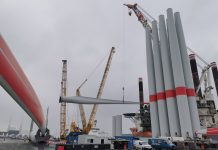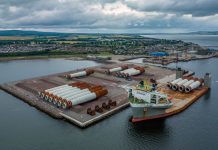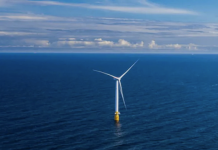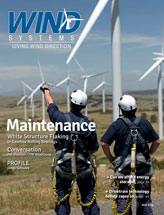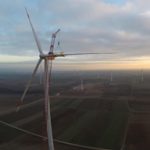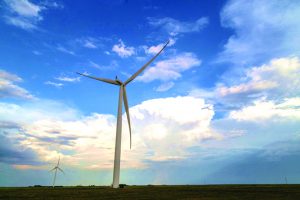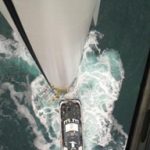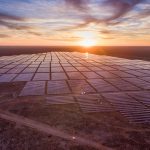Wind energy continued its forward march in 2013 as an ever-growing piece of the mainstream U.S. electricity mix, with a record number of projects and generating capacity under construction by year’s end, billions of dollars of continued private investment, and new records for generation in many areas, according to the AWEA U.S. Wind Industry Annual Market Report Year Ending 2013, released on April 10.
The U.S. industry ended 2013 with 61,110 MW operating in the U.S. across 46,100 wind turbines in 39 states and Puerto Rico. The 905 utility-scale wind projects operating here exceeded 4 percent of the U.S. electricity generation during 2013, and are now able to power the equivalent of 15.5 million American homes. They will continue to deliver new, affordable, clean generation year after year. Meanwhile, an average of $15 billion a year is invested in new projects, resulting in the industry posting 19.5 percent average annual growth over the past five years.
“Increasingly, America is powered by wind energy,” said AWEA CEO Tom Kiernan. “As utilities and Americans become more familiar with this affordable and reliable energy source, they want more of it. Our industry is responding with record construction numbers, more business for American factories, and more deployment of wind energy that has become a new cash crop for our farmers and ranchers.”
The year began slowly after a last-minute extension of the federal Production Tax Credit (PTC) for renewable energy on Jan. 2, 2013. The supply chain had slowed down during the months preceding the threatened expiration. As a result of the slowdown and the months needed to region momentum, the industry saw a 92 percent drop in installations, down from a record 13,131 MW in 2012 to just 1,087 MW in 2013. With a historic 12,000 MW and 100 projects under construction as 2013 drew to a close, this boom-bust pattern could continue if policy uncertainty continues.
Wind energy has become the primary choice for new energy capacity in wind-rich regions. Between 2011 and 2013, wind energy delivered roughly 60 percent or more in the Pacific Northwest, Plains states, and Midwest, and as much as 80 percent in the upper Midwest. As a matter of fact, renewable energy sources were the single largest source of new energy capacity in all regions across the country outside of the Southeast and Mid-Atlantic, from 2011 through 2013.
Wind’s continued market penetration is also evident nationally: It contributed 31 percent of all new electric generation capacity in the U.S. over the past five years, underscoring how both utilities and ratepayers are gaining a better understanding of wind’s affordability, reliability, and other benefits.
Generation & penetration records
Wind energy provided over 60 percent of the electricity on utility Xcel Energy’s Colorado system at one point last year, among several regions that broke records for wind generation at a given time.
Year-round, wind energy in 2013 topped the 25 percent milestone in both Iowa and South Dakota. In total, wind energy comprised 4.13 percent of the nation’s electricity generation mix by year’s end.
Advancing technology lowers costs
The cost of wind energy dropped 43 percent between 2008 and 2012, according to the U.S. Department of Energy. That reduction comes largely from the industry’s continuing technological advances in several areas, from improved siting techniques to larger rotor diameters and taller towers, which now average 97 meters and 80.3 meters respectively, increasing energy production by accessing higher wind speeds at taller elevations.
Geographically disperse benefits
Wind energy activity is now occurring in all 50 states, from project construction and operations to wind-related manufacturing. The 905 U.S. wind projects span 39 states while the 560 manufacturing facilities span 43 states. The majority of U.S. Congressional Districts, over 70 percent, have a wind project, a manufacturing facility or, both.
Positive environmental impact
The report notes that operational wind energy projects, combined with the projects under construction, will avoid 115 million tons of carbon dioxide emissions annually—more than 5 percent of U.S. power sector emissions—while avoiding the consumption of over 36 billion gallons of water each year, because wind turbines use virtually no water in operation.
Transmission infrastructure build-out
One important trend that bodes well for the industry is in the area of transmission, which is needed to link America’s world-class wind resources with demand centers. Over 10,000 MW of new transmission capacity was completed in 2013, and near-term projects could deliver another 60,000 MW of wind energy—allowing a doubling of the total amount of capacity installed today. These power lines result from years of work, which must continue if growth is to be sustained.
The robust construction pace and other favorable indicators come as discussions continue in Congress over extension of the PTC, which expired at the end of 2013. The wind industry needs an extension of tax incentive in 2014 to restart the development process and continue the exciting momentum that ended 2013
















